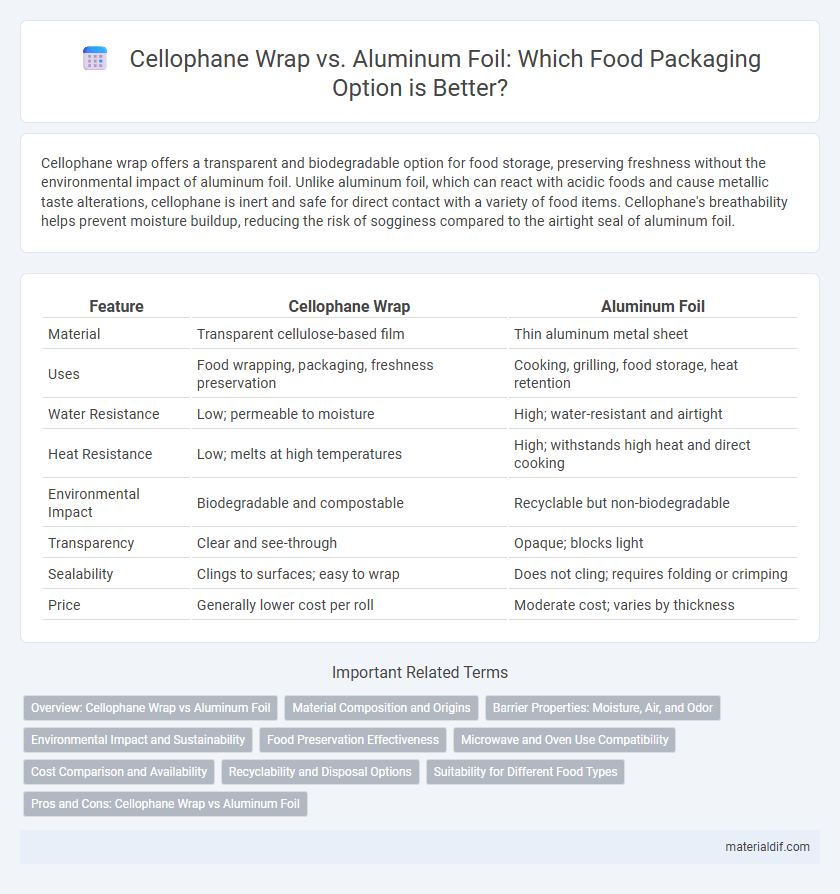Cellophane wrap offers a transparent and biodegradable option for food storage, preserving freshness without the environmental impact of aluminum foil. Unlike aluminum foil, which can react with acidic foods and cause metallic taste alterations, cellophane is inert and safe for direct contact with a variety of food items. Cellophane's breathability helps prevent moisture buildup, reducing the risk of sogginess compared to the airtight seal of aluminum foil.
Table of Comparison
| Feature | Cellophane Wrap | Aluminum Foil |
|---|---|---|
| Material | Transparent cellulose-based film | Thin aluminum metal sheet |
| Uses | Food wrapping, packaging, freshness preservation | Cooking, grilling, food storage, heat retention |
| Water Resistance | Low; permeable to moisture | High; water-resistant and airtight |
| Heat Resistance | Low; melts at high temperatures | High; withstands high heat and direct cooking |
| Environmental Impact | Biodegradable and compostable | Recyclable but non-biodegradable |
| Transparency | Clear and see-through | Opaque; blocks light |
| Sealability | Clings to surfaces; easy to wrap | Does not cling; requires folding or crimping |
| Price | Generally lower cost per roll | Moderate cost; varies by thickness |
Overview: Cellophane Wrap vs Aluminum Foil
Cellophane wrap offers a transparent, breathable barrier ideal for wrapping fresh produce and delicate foods, preserving moisture while allowing airflow that reduces spoilage. Aluminum foil provides an opaque, impermeable shield with superior heat retention and protection against light, making it suitable for cooking, grilling, and long-term storage. Choosing between cellophane wrap and aluminum foil depends on the food's need for visibility, ventilation, and thermal insulation.
Material Composition and Origins
Cellophane wrap is made from regenerated cellulose derived from wood pulp, making it biodegradable and breathable, while aluminum foil consists of thin sheets of aluminum metal, known for its impermeability and heat conductivity. Cellophane was first developed in the early 20th century as a transparent packaging film, whereas aluminum foil dates back to the early 1900s, originally used for insulation and later for food wrapping. The natural origin of cellophane contrasts with the metallic, mined source of aluminum foil, influencing their environmental impact and specific uses in food preservation and packaging.
Barrier Properties: Moisture, Air, and Odor
Cellophane wrap offers moderate barrier properties, effectively preventing moisture and some odors from penetrating while allowing limited air permeability. Aluminum foil provides superior barrier protection against moisture, air, and odor due to its dense, non-porous structure, creating an almost complete seal. For packaging applications requiring maximum preservation of freshness and odor control, aluminum foil is typically preferred over cellophane wrap.
Environmental Impact and Sustainability
Cellophane wrap, made from biodegradable cellulose derived from wood pulp, offers a more environmentally friendly alternative to aluminum foil, which is energy-intensive to produce and non-biodegradable. Unlike aluminum foil, cellophane decomposes naturally in composting conditions, reducing landfill waste and microplastic pollution. Choosing cellophane wrap supports sustainability initiatives by minimizing carbon footprint and promoting renewable resource use.
Food Preservation Effectiveness
Cellophane wrap excels at maintaining food freshness by allowing moisture and gases to pass through, which helps prevent condensation and sogginess, making it ideal for wrapping fruits and vegetables. Aluminum foil offers superior protection against light, oxygen, and moisture, effectively preserving flavors and preventing freezer burn, especially for meats and cooked dishes. Choosing between cellophane wrap and aluminum foil depends on the specific food item and storage needs, with foil favored for long-term preservation and cellophane for short-term freshness.
Microwave and Oven Use Compatibility
Cellophane wrap is microwave-safe and allows food to be heated without melting or releasing harmful chemicals, making it ideal for reheating. Aluminum foil should never be used in microwaves due to the risk of sparks and potential fire hazards. For oven use, aluminum foil is suitable for lining trays or wrapping foods to retain moisture, while cellophane wrap is not heat-resistant and will melt in oven temperatures.
Cost Comparison and Availability
Cellophane wrap is generally more affordable and widely available in retail stores and online compared to aluminum foil, which tends to be pricier, especially premium brands. Availability of cellophane wrap is consistent across grocery and packaging supply outlets due to its popularity for lightweight wrapping, while aluminum foil is commonly found but may vary in thickness and quality, affecting cost. Consumers often choose cellophane for budget-friendly packaging solutions, whereas aluminum foil is selected for durability despite the higher price point.
Recyclability and Disposal Options
Cellophane wrap is biodegradable and compostable, making it a more environmentally friendly option for disposal compared to aluminum foil, which is recyclable but often contaminated by food residues. Aluminum foil requires proper cleaning before recycling to avoid contamination in recycling facilities, whereas cellophane can break down naturally without specialized processing. Choosing cellophane wrap reduces landfill waste due to its organic composition, while aluminum foil's recyclability depends on local recycling program guidelines and consumer participation.
Suitability for Different Food Types
Cellophane wrap is ideal for wrapping fresh fruits, vegetables, and baked goods because it is breathable and prevents moisture buildup, extending freshness without causing sogginess. Aluminum foil is better suited for cooking or storing meats, casseroles, and foods requiring heat retention, as it provides an airtight seal and withstands high temperatures. Choosing between cellophane wrap and aluminum foil depends on the specific storage needs and cooking methods associated with different food types.
Pros and Cons: Cellophane Wrap vs Aluminum Foil
Cellophane wrap offers excellent breathability, making it ideal for keeping produce fresh by preventing moisture buildup, but it is less effective at sealing out air and odors compared to aluminum foil. Aluminum foil provides superior protection against light, air, and moisture, making it well-suited for cooking and long-term food storage, though it is less environmentally friendly due to its production and disposal impacts. Choosing between cellophane wrap and aluminum foil depends on the specific use case, balancing factors like freshness preservation, environmental impact, and barrier properties.
Cellophane Wrap vs Aluminum Foil Infographic

 materialdif.com
materialdif.com